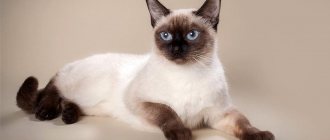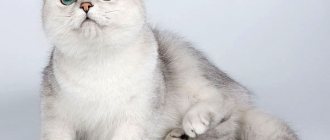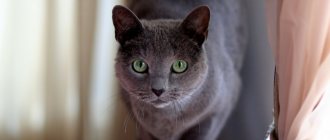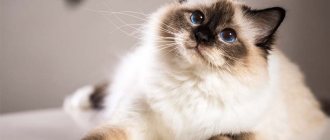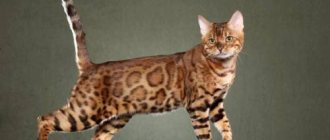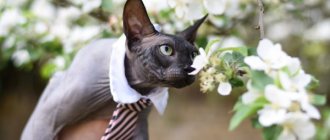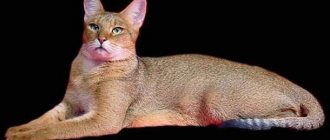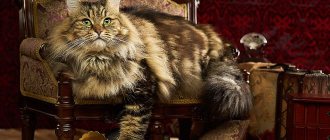If you want to become the owner of a special cat of an ancient breed, pay attention to the fluffy beauty of the Sacred Burma breed. It is not for nothing that Burmese cats are called sacred, because their history is shrouded in secrets and legends. These are incredibly beautiful, smart and kind animals, so human-oriented that they are called human.
Sacred Burma feels comfortable in the company of people and knows how to adapt to any mood of its owners. And if a quarrel is brewing in the family, the pet will not remain on the sidelines. It has long been noted that the Burmese have a gift: they know how to defuse the situation in some incomprehensible way. And now, the household members have already forgotten what was the subject of their quarrel, and are smiling at each other again.
Characteristics of the Burmese cat - character and habits
Burmese are truly aristocrats in the world of cats, as evidenced by the noble manners that nature has endowed them with. It is unlikely that you will find another animal with such a balanced character. They cannot be called phlegmatic, but they also do not have excessive activity: in general, they are the golden mean between the Siamese and the Persian.
Sacred Burma is ready to give warmth and affection when it is desired and pleasant to a person. And if the owner is busy, they will not pester you, demanding attention. Sacred Burma gets used not to a place, but to a person. If you are moving, it is important that you take your pet with you.
When describing Sacred Burma, one can recall many positive epithets, and all of them will correspond to the truth. The Burmese cat is naturally endowed with tact and aristocratic manners. She is smart, affectionate, sociable, obedient, affectionate and gentle towards people. In the evening hours, the pet loves to bask on the owner’s lap, but in moments of fun it will entertain the household with hilarious jumping and games.
The Sacred Burma is not characterized by aggression or fearfulness, but she is not short of curiosity. If guests come to the house, the fluffy cat will come out with curiosity to greet strangers. Sacred Burma strives to be aware of the family's affairs and can spend hours observing what is happening in the house, poking her curious nose everywhere.
Intelligent Burmese are not vindictive; they do not have the habit of scratching wallpaper and furniture. And the owners’ hands, too, as a rule, remain intact.
Description of the Sacred Burmese breed and photo of the Burmese cat
The Sacred Burma is a cat breed that combines the external characteristics of the most famous breeds in the world - the Persian and the Siamese.
One of the most mysterious modern cat breeds is the Sacred Burma, or Burmese cat.
The ancestors of these beautiful animals lived in Burmese temples. They embodied calm, served as devoted assistants to the monks, and also guarded religious shrines.
There is a legend according to which these cats managed to save the temple from fire several times and even prevent robbery and attack by invaders. That is why the name “sacred Burma” is so symbolic.
The Burmese got its characteristic color thanks to special genetics. Scientists theorize that crossing Persian and Siamese breeds allowed these cats to acquire soft fur and distinctive white “gloves” on their paws.
Burms are incredibly calm and unpretentious pets. Therefore, people of any temperament can place them in their homes: they will calm choleric people, and cheer up phlegmatic people a little.
Sacred Birman (photo of a long-haired Burmese cat)
Description of the breed
The Burmese breed is rightfully called unique. She is the only one whose name contains the word “sacred” and whose name is usually written with a capital letter. Burmese cats also have external features. This is the famous Burmese color - the presence of snow-white socks (on all four legs) and spurs (on the hind legs).
In purebred pets, these characteristic markings have a certain shape and are located symmetrically. It is difficult to obtain animals with such characteristics, so breeding the Burmese breed is not an easy and responsible matter.
Today, the Sacred Burma (English Birman, Sacred Birman, SBI) is recognized by all felinological associations of the world as an independent breed. In accordance with this, there are several breed standards.
Appearance - what sacred Burma looks like
The development of the modern variety of the Sacred Burma breed took place according to a special breeding program with the participation of Siamese, Persian and European shorthair breeds. Thus, its representatives absorbed most of the European lines. All existing standards give a similar description of the exterior, with the exception of some details. This is how the FIFe breed standard describes the Sacred Burma:
- The head is round in shape, with expressive features: large lower jaw, full cheeks, developed chin. The convex forehead turns into a straight, slightly curved nose line (Roman profile) of medium length, the stop is not visible, but there is a small depression (in accordance with the SCFF standard - the stop is present).
- Cats' ears are small, slightly inclined, with wide bases and rounded tips without tassels. The distance between the ears is significant. The outer sides of the ears are pubescent, and long tufts of hair grow inside.
- The eyes are large, expressive, round or slightly oblong. All types of color are characterized by a deep blue color of the iris.
- The neck is short or medium length, with developed muscles, richly pubescent.
- The Burmese cat is an animal with a tightly knit, elongated body and strong bones. Other features of the breed: squat and stocky figure format, well-developed muscle corset. Males are somewhat larger and more massive than cats.
- The limbs are short, strong, muscular, well furred at the level of the hips. Rounded small paws with thick pads. There are tufts of thick fur between the toes.
- The tail is of medium length, densely pubescent and resembles a plume. Pets wear it gracefully raised.
Possible disadvantages and disqualifying vices of the Holy Burma:
- The shape of the head is close to the format of a Siamese or Persian.
- Strabismus.
- Defects of the caudal vertebrae.
- Various color irregularities: absence of white markings on paws, light spots on colored areas (or colored on white areas), partially pigmented nose, white spot on genitals.
A unique feature of Sacred Burma is its special morphology. Professional breeders, when working with Burmese, try to preserve the entire set of breed characteristics that indicate the uniqueness of the breed. This is not an easy task, which is why the price of Sacred Burmese kittens is very high.
Size and weight
Sexual dimorphism in the representatives of the breed is very pronounced, that is, males are large and representative, females are graceful and sophisticated.
- the weight of an adult cat is 5-6 kg, with a height of 25-30 cm;
- The weight of an adult cat is 3-4 kg, with a height of 24-27 cm.
Thanks to its long coat, the Sacred Burma appears to be a massive animal, although, in fact, its size and weight are typical of most domestic cats.
Wool
The Sacred Burma has a beautiful semi-long coat with a soft, silky texture that glides under your fingers. The length of the guard hair varies from semi-long to long. Thus, the chest, neck, back, sides, tail and pant area are the most richly furred. Decorating hair here can reach 10 cm or more.
The structure of the outer hair (it is thick and spinous) and the absence of undercoat make it easier to care for the coat, because it is not prone to tangles. Keeping your pet's coat in excellent condition is easy.
In 1995, by crossing the Sacred Burmese with representatives of the oriental cinnamon tabby breed, a short-haired variety of the Burmese breed was developed. The first representatives of the shorthaired Birman appeared in the New Zealand nursery Birman Cat Club of New Zealand.
Colors
All representatives of the Sacred Burma breed have a color point type (translated from English as a colored dot). Another name for this color is Siamese or Himalayan.
The peculiarity of all color-point colors is that some areas of the body (namely, the muzzle, paws, ears, tail) are painted in a special way. The painted areas contrast well with the main coat, which is light beige (eggshell shade).
This color is called “multi-temperature”, since the recessive “CS” gene takes part in its formation, which is active only on the coldest parts of the body (points). In animals with the “CS” gene, only those parts of the body that are located on the periphery of the circulatory system are stained.
For the Sacred Burma, the breed standard recognizes a wide variety of point color types. Earlier than others, the colors blue point (blue point) and seal point (dark brown point) were recognized, which are considered classic. Other colors appeared later, namely in the 60s of the twentieth century. Among them are:
- lilac point;
- chocolate point;
- cream point;
- red point;
- tortoiseshell point;
- tabby point.
Features of the Sacred Burma color:
- The tips of all four paws have snow-white markings called gauntlets. The markings cover the area of the phalanges. Standard requirements: pure white shade, pairwise symmetry of marks.
- The hind legs are decorated with inverted V-shaped markings extending down to the hock joint (spur).
Sacred Burma has a long period of maturation. Kittens are born completely white, gradually acquiring a point color. The points become most contrasting and bright only by the age of three. The markings on the paws remain snow-white for life.
Eyes
All representatives of the Sacred Burma breed have a rich blue tint to the iris. It is also called Royal Blue.
Lighter or darker colors are acceptable. Thus, representatives of the breed with darker colored points (seal point color) have a more saturated, deep (cosmic) eye color. Lighter blue point pets have a very beautiful sky blue eye color.
Coat color
The Burmese cat wears color point colors (translated into Russian as “colored dot”, “colored mark”). It is vaguely similar to the color of Siamese and Himalayan cats.
The main color of the fur is white, cream. The paws, muzzle and tail are highlighted in a contrasting color. White “gloves” are retained on all paws, which should be symmetrical on the front and hind paws. Paw pads are brown, dark brown, pink.
Interesting!
Breeders call this color multi-temperature. The recessive gene “CS” is involved in the formation of color. It is active in the coldest areas of the body. These are color points of a dark shade. The photographs perfectly convey temperature zoning.
Blue point
The blue Burmese cat is common and is considered a classic. The blue cat was the first of the breed. Her eyes are lighter compared to other representatives of the Burmese cat breed. The marks are highlighted in a cold, blue color with a gray tint. An excellent example is shown in the photo.
Interesting!
The Blue Burmese cat is very similar to the Thai breed, which is why they are often confused.
Dark brown point (seal point)
The color shown in the photo is considered a classic. The markings are dark brown or chocolate-colored to contrast with the light beige coat. The brown Burmese cat has deep dark blue eyes.
Lilac point
In many ways, the descriptions of the colors agree with each other. The only difference is the color of the points. In the lilac color, they are painted in a gray-purple hue. The nose is highlighted in a darker color, which is clearly visible in the photo. The lower parts of the limbs remain white.
Interesting!
An ancient legend says that special color marks appeared on the animal’s fur for a reason. This makes it easier for the patron goddess to protect her charges, even when she sees them from behind.
Chocolate point
The chocolate-colored Burmese cat has bright blue eyes, which even pictures convey. The tail is painted the same color as the “mask” on the muzzle, or highlighted with a shade of chocolate. The main coat color is milky, ivory. The paws are decorated with snow-white “gloves”.
Cream point
This Burmese cat has a white base coat. Let's say a cream shade or ivory color. The markings are highlighted with a creamy tint. Sometimes it blends in with the fur, as in the photo. The tail may be brighter.
Red point
The Burmese cat can even be red. The points are colored in a delicate carrot shade. The muzzle, ears, tail and paws stand out. The completion of the limbs remains perfectly white. Eye color is blue. The red-haired beauty rarely appears in a litter, so it is highly valued.
Tortie point
The points are tortoiseshell in color. 2-3 shades appear on the face, like the Burmese cat in the photo. There are spots of red, chocolate, and cream colors. Points on the paws can follow the palette. Less often they are painted the same color.
Tabby point
Distinguished by striped points. They can be red, gray, chocolate. The pattern is especially pronounced on the muzzle and paws. The ears and tail are highlighted in a dark shade. The nose may have a gray or pinkish color. Eyes remain blue from birth.
Interesting!
With the naked eye you can see the similarities between the Burmese and the Neva Masquerade breed. They have a characteristic Siamese coloration. However, the Neva Masquerade has green or gray eyes. Also, the Neva Masquerade breed is less patient and kind.
Life expectancy - how long do Burmese people live?
Sacred Burma is a long-liver. The average lifespan is 15-18 years, which is not the limit. Measures such as careful adherence to the laws of selection, exclusion from the breeding program of individuals with genetic abnormalities, and proper management of pregnancy in females serve to give birth to healthy kittens and extend the life of the Sacred Burma, which has been proven more than once by examples.
Here is the most famous: a Burmese cat named Lady Catalina from the Australian city of Melbourne lived for 35 years, for which she was awarded an entry into the Guinness Book of Records.
Are Burmese cats hypoallergenic or not? How often do they shed?
The Sacred Burma has a soft, silky coat without undercoat. If the cat is healthy and well-groomed, it will not shed much. Seasonal molting periods pass quietly. Care at this time consists of daily combing. This is quite enough to prevent the presence of a large amount of fallen hair on furniture and surfaces of the house.
The Burmese cat, to a lesser extent, but can still cause allergies in a sensitive person, because it is known that an allergic reaction does not develop to cat fur, but to a special protein contained in the secretion of the salivary glands, urine, sebum and other fractions that fall on the skin. surface of the coat. You can somewhat control the manifestations of allergies by frequently bathing your pet and observing personal hygiene rules.
It has been proven that in children, the body’s sensitivity to the Fel d1 protein develops less frequently if the child lives next to a furry pet from an early age. In this case, the immune system seems to adapt to constant contact with the allergen.
Friendliness
Sacred Burma is genetically very attached to humans. Communicative qualities, such as friendliness, sociability, and trustfulness are represented in these cats to the maximum extent, and these qualities are manifested to a greater extent in cats than in cats.
Sacred Burma is recommended for large families with children and elderly relatives. In this case, it will be easier to arrange so that one of the household members is always at home and can communicate with the pet.
Burmese kittens very quickly socialize and adapt to the conditions of the home where they will live. They love to be in the thick of things and take part in the daily affairs of the family. Another striking feature of Sacred Burma is its friendliness towards strangers. The Burmese cat will not hide from guests, but, on the contrary, will come out to meet you with curiosity.
Castration and sterilization
Puberty in cats begins at the age of 7-8 months. If the owner does not plan to breed them, they are castrated or sterilized at the age of 7-10 months. Consider how old the animal is. At the age of 3-5 years, the operation is not so easy to tolerate.
The operation takes no more than 15 minutes. Within a couple of hours the pet comes to its senses. Recovery takes about 2-3 days. Spayed and neutered animals live longer and experience less stress.
If you skip this step, the pet will suffer from the inability to perform reproductive functions. He will begin to mark his territory and ignore the litter box.
Burma and children
Burmese kittens get along well with children, especially if the babies are raised together from diapers. You can leave your pet with your child without fear, knowing that it will not bite or release its claws.
Usually Burmese people patiently endure the not very skillful caresses of babies. First, you should still talk to the child, explaining that the cat is a living creature and you need to be careful with it.
Older children who love and know how to handle animals tend to find contact with Sacred Burma. Children and animals often become best friends and enjoy playing together.
Attitude towards other animals
Sacred Burma, as a rule, finds a common language with other pets sharing the same territory with her (although at first, manifestations of jealousy are not excluded). Smaller animals should still be isolated, since the hunting instinct of the Burmese is quite developed.
To eliminate manifestations of jealousy, the owner must develop the correct tactics of behavior: the animals should be given equal attention, without depriving anyone. Conflicts are excluded if animals grow up together, getting used to the house, owners, and surroundings.
The issue of dominance may arise if animals appeared in the house as adults (especially if they are unsterilized). Castrated and sterilized Burmese, as a rule, do not display jealousy or aggression.
Reviews
Before purchasing an animal, I always recommend reading owner reviews about the breed. I will present some of them in this article. All reviews are taken from the Otzovik website.
Curious cat
The author says that the cat appeared in the house by accident and has been living with the family for 20 years. She happily travels to the country and has adapted well to life both in an apartment and in a private house. It is unpretentious in food, but prefers raw fish, meat, cheese and milk. In winter, they are fed with good food. There are no problems with leaving.
Cat with character
The author of this review draws attention to the character traits of the Burmese cat. The animal is wary of strangers, does not go into the arms of strangers, and sometimes hides. During the period of estrus, the pet is very restless, but this is the natural state of females at this time. It is best to sterilize the animal to protect your nerves and the health of the cat.
Harmonious animal
The Burmese cat who lives with the author of the third review is very active and loves games. The author notes that the animal does not impose its society, but can demand by voice to perform some action. He recognizes only his master, loves to spend time with him and obeys him unquestioningly. Particular attention should be paid to the pet's nutrition: it must be balanced, otherwise health problems will begin.
Playfulness
Burmese kittens are very playful and incredibly funny. Often, this love of play remains with pets for life. It has been noticed that cats are more affectionate, sociable, and playful. Cats are less playful, they are more likely to show independence and wisdom.
As Burmese people age, games should become more intellectual. It’s not appropriate for an adult cat to chase a candy wrapper, but a cat puzzle, learning a series of commands or simple training will be a worthy pastime.
Cat health and care for the Burmese breed
A purebred Burmese kitten needs high-quality veterinary care. By nature, animals have strong immunity and stable health, however, like other pets, they can suffer from urolithiasis, obesity, food allergies and kidney failure.
Some experts also identify a number of diseases to which the Burmese are susceptible at the genetic level:
- corneal dermoids;
- pathologies of the vestibular apparatus;
- hypertrophic cardiomyopathy.
If there is a suspicion of any congenital or acquired diseases, the animal owner should contact a veterinary clinic to prescribe treatment.
With proper attention and veterinary support, Burmese can live for 12-15 years.
Caring for cats of this breed will not be particularly difficult. Cats' coat is silky, with a minimal amount of undercoat, so it is easy to comb and rarely forms tangles.
Grooming should include the following procedures:
- regular brushing;
- washing the eyes to prevent the formation of tear stones;
- cleaning the ears;
- nail trimming;
- brushing teeth to prevent tartar and massage gums.
Kind and calm, the Burmese is an excellent choice for most families. These cats are moderately affectionate and playful, they will melt the hearts of all members of their new family. The cat needs minimal care, and its maintenance will not cause much trouble for the owners, because the animals are very neat, intelligent and moderately temperamental.
How to cope with loneliness
The Sacred Burma is a very social animal and does not tolerate loneliness well. Past life experience is of great importance to her. A kitten raised in a large family will constantly need affection and extra attention.
It is very good if one of the household members is always at home. In this case, the pet will not be deprived of attention. If adults and children go about their business every morning, leaving the Burmese alone to while away the time in the apartment, he may feel lonely. In the evening, you need to reward the sufferer by giving him maximum attention and participation.
It is highly not recommended to leave Sacred Burma alone for a long time. Being isolated and separated from its beloved owner, the pet will experience severe psychological discomfort, which can develop into depression.
Our Burmese live next to us, the kittens grow and are raised at home.
They leave for a new home at 12 weeks, with a European veterinary passport, microchipped, vaccinated against viral diseases and rabies. Each kitten has a pedigree and a contract is concluded. Adult animals are veterinary certified to test for genetic and other diseases.
Cost of kittens
For those who want to be aware of how much a Burmese cat costs, it is easy to guess that the prices for purebred kittens are high:
- Pet-class kittens cost from 40 thousand rubles. These kittens are subject to mandatory neutering at the age of one year.
- The cost of breeding class kittens is 70-100 thousand rubles.
- A show-class kitten costs 100-150 thousand rubles.
If the goal is to choose a purebred kitten for further exhibition or breeding work, it is recommended to invite an independent expert who will help you make a good choice, check the availability of all documents, and conduct the transaction correctly.
How to choose a kitten, its cost
In order not to run into scammers, it is better to buy a Burmese as a cat from a specialized cattery. It is important not to confuse it with the Burmese, this is a completely different breed. A similar name often causes confusion in the purchase history.
Characteristics of a healthy kitten:
- no discharge from the nose or eyes;
- clean ears;
- clear and conscious view;
- interest in the environment;
- clean thick fur;
- You need to remember that healthy kittens are extremely active.
You need to ask the breeder for a vaccination passport, a package of documents that includes a pedigree, and possibly studies confirming the health of the pet. It’s worth asking what kind of filler and food the kitten is used to.
Important!
At 3 months the kitten should have its first vaccinations. The breeder must train him to use the litter tray.
Inspection of the kitten's parents is mandatory. Their characteristics must be satisfactory. Aggression from animals is not allowed.
It is better for buyers to find out in advance how much a show-class, breed-class and pet-class kitten costs. The appearance and price of such kittens vary greatly.
If a kitten can participate in exhibitions and breeding and has a full package of documents, then its cost varies from 40 to 80 thousand rubles.
If the pet does not have documents, has minor defects or disadvantages, then it can be purchased much cheaper - for 10-25 thousand rubles.
Interesting!
Initially, the Burmese cat gives birth to kittens with light fur. After a few weeks, a brown mask and markings on the paws become visible. Full color is formed by 1.5 years. With age, the coat becomes darker and darker.
Pictures of kittens well convey their color in the first weeks of life.
Burmese catteries
Anyone who wants to enjoy communication with representatives of the unusual and amazing Sacred Burma breed is recommended to contact professional breeders.
- "WHITE PAWS" (Moscow)
- "LAKSHESTAR" (Moscow)
- "Bijou Sacre" (St. Petersburg)
- "ZAFIRO SAGRADO" (Yuzhno-Sakhalinsk)
- "LV*Marikota" (Kaliningrad)
- "White Paws" (Moscow)
- "Tarnis" (Moscow)
Owners of certified nurseries dearly love their charges and make every effort to ensure that they grow up as healthy, well-mannered and socially adapted animals. All kittens are vaccinated promptly, dewormed, and taught to use a litter box and scratching post. The animals are healthy and active because they are not kept in isolation.
Birman catteries in some cities:
Nurseries in Moscow
- sacred-burman.ru
- www.burmania.ru
- s.lakshestar.ru
- burman-cats.ru
- milamos.ru
- nyanhouse.ru
Nurseries in St. Petersburg
- www.bijou-sacre.ru
- vk.com/club130412856
Nursery in Kaliningrad
- marikota.com
Nursery in Minsk
- elegant-cat.ru
Nursery in Kyiv
- www.sacredbirman.com.ua
The cost of a Burmese kitten depends on the breed quality, gender and special agreements between the future owner and the breeder. Sometimes nurseries give away adult animals taken out of breeding for practically nothing.
Real Burma cannot be cheap! In this breed there are never “rejected kittens” that the breeder is happy to push away. This is a very rare and, due to its unique qualities, an elite breed.
Real Burmese are not sold outside nurseries!
Don't be fooled.
Care and maintenance
The Sacred Burma is an unpretentious animal, so caring for it is not difficult. Burmese do not need a large living space and can be kept in a city apartment. They are allocated a part of the room where they place a comfortable lounger or rest house, a scratching post, a play complex, and toys.
For walks outside (curious Burmese love to walk) they buy a harness. They practice visiting the street only in warm, calm weather, since animals are susceptible to colds.
By nature, Sacred Burma has a weak vestibular system, which is why she cannot control the position of her body when falling. Strong anti-cat nets should be installed on all windows to prevent pets from accidentally falling out of the window.
What to feed
Sacred Burma, as a rule, has a moderate build: she does not have a tendency to overeat and gain weight. Burmese cats are aristocrats in everything: for them it is not so important that there is a lot of food. It is much more important that the feeding is truly tasty and of high quality.
Felinologists say that any type of diet is acceptable for pets, the main thing is that the food meets quality standards.
With a natural type of diet, the ideal choice for Sacred Burma would be lean meat: turkey, rabbit, lamb or chicken. The meat is given boiled, cut into medium-sized pieces. The diet is supplemented with low-fat fermented milk products with sufficient calcium content, stewed vegetables, and water-based porridge (in small quantities).
Occasionally, the pet is treated to a chicken or quail egg, unsalted cheese, and boiled sea fish without bones. A natural diet includes vitamin and mineral supplements necessary for the proper development and strengthening of the body. Food from the owners' table with a high content of fat, salt, and preservatives should be excluded from the diet.
If an industrial type of diet is chosen, then you should pay attention to high-quality food from popular manufacturers with a sufficient content of proteins, plant fibers, vitamins, probiotics and limited fat content. Recommended brands:
- Pro Plan;
- Hills;
- Acana;
- Origen.
Grooming
Thanks to the special structure of the topcoat and the absence of undercoat, caring for the Sacred Burmese coat is easy. In order for your pet to look neat and well-groomed, it is enough to comb it with a comb once a week, removing dead hairs.
Additionally, it is worth treating the wool with a soft massage glove brush to stimulate the follicles and activate blood circulation. During periods of shedding, brushing is carried out daily.
Pets are bathed as their fur becomes dirty, approximately once every 3-4 months. It is mandatory to use shampoo for long-haired animals, which provides nutrition and shine to the hair.
It is necessary to take timely care of the eyes, ears, and teeth of the Sacred Burma. The eyes require the most careful attention: due to deformation of the tear ducts, increased lacrimation may occur. The discharge is carefully removed by treating the eye area with a mild antiseptic.
Pets' teeth are periodically cleaned, and the oral cavity is examined for the formation of tartar - a source of dental problems.
The tips of the claws are trimmed with a nail clipper as needed.
Potential Health Problems
Despite numerous crossings, Sacred Burma has retained good heredity and high immunity. Pedigree hereditary pathologies are rare. Regular preventative examinations with a veterinarian help to diagnose them at an early stage.
- Hypertrophic cardiomyopathy is a dangerous hereditary heart disease. The pathology develops gradually and is usually diagnosed in the later stages. There is no effective treatment for the pathology; the only way is surgery.
- Corneal dermoid is a benign growth of eye tissue that appears as a thin film on the cornea. After a simple surgical intervention, the function of the organ of vision is completely restored.
- Another hereditary pathology leading to disqualification is congenital strabismus.
- Spongiform encephalopathy is a severe neurological pathology caused by an insufficiently studied infectious agent. It has been found that animals become ill after eating contaminated food. The pathology is manifested by impaired coordination of movements, tremors, increased salivation, and fever.
Sacred Burma is prone to colds and needs protection from low temperatures and drafts. The room should maintain a temperature environment that is comfortable for them - 23-25°C.
Professional breeders maintain the genetic health of the Sacred Burma through careful selection, genetic testing, and exclusion of individuals with deviations from the breeding program. When purchasing from hand, the buyer will not receive any guarantees of the health and breed of the pet.
Maintenance and care, nutrition
In terms of care, the Burmese cat does not present any difficulties. Burms easily adapt to changing environments and can withstand transportation, so you can take your pet with you when traveling.
Their diet has some peculiarities. Although Burmese are not gluttonous, they are picky about food. Experts recommend feeding your pet high-quality, balanced food that contains a small amount of carbohydrates. The color of the coat is adversely affected by foods containing high concentrations of copper and iodine; they can lead to darkening of light areas, so liver, algae and cereals should be excluded from the pet’s diet.
To prevent hairballs from getting stuck, you can give your cat a small amount of grass. An adult is fed twice a day - morning and evening, the average serving is about 300 g. Kittens require more frequent feeding - 5 times a day, 200 g.
Birman kittens
Burmese wool does not require complex care. Their fur does not form tangles. It is enough to carefully comb out the lost hair with a special comb with sparse teeth once a week. During periods of intense shedding, a furminator is better suited for removing fluff, as it can easily remove lost hairs. An obedient, shiny coat is a sign of a cat’s health, so dulling of the coat, changes in color, or excessive hair loss may indicate illness or an incorrectly selected diet.
To maintain the quality of the wool and its color, it is recommended to keep the Burmese at a temperature of +22-25 degrees. Cold lightens dark areas.
Bathing is not a problem for Burmese cats. As a rule, they tolerate it steadfastly. Frequency of washing - no more than once a month. It is important that the water is warm; you need to use only special cat shampoos. To choose a product, you can seek advice from specialists or a breeder.
In general, cats are unpretentious and have no disadvantages. Defects include only character traits that require constant attention and affection, as well as a possible change in color if the animal is not kept properly.
Pros and cons of the breed
By purchasing a purebred Burmese, the future owner receives a unique animal. Fans of the Sacred Burma breed claim that they are not at all like other cats, highlighting a number of advantages:
- Unusual, noble appearance. The breed can rightfully be called elite. The fluffy fur, the unusual color and the intense gaze of blue eyes are striking.
- High level of socialization. They say that the Burmese feels the owner and interacts with him. These cats are friendly, sociable, balanced, and tactful.
- Balanced character. Kittens easily adapt to a new home and accept the laws of family life. Usually there are no problems with toilet training or scratching posts. The Burmese are not vindictive and do not tend to damage wallpaper or furniture.
- Sacred Burma has good health and long life expectancy. With satisfactory care, they live freely up to 18 years, and sometimes longer. If you regularly bring your pet for medical examination, then there is a high probability that he will live a long life without suffering from anything serious.
- Easy care, moderate shedding.
There are also disadvantages:
- Due to the lack of undercoat, the Sacred Burma is prone to colds. Excessive exposure to cold air can cause the coat to darken.
- Burmese are jealous, which creates problems when keeping multiple animals in a family.
- Sacred Burma requires healthy eating and careful selection of diet. Due to their sensitive digestive system, economy class food is not suitable for them.
- The price of kittens is very high. A purebred baby costs from 40 to 200 thousand rubles.
History of the breed
The Burmese Sacred Cat is one of the oldest cat breeds. The exact age is unknown, but its homeland is Burma (now Myanmar) - the Asian capital, where Burmese cats are visible and invisible. History tells that these cats lived in monasteries. In a Buddhist country, animals were given special respect, believing that they protect people’s homes from dark forces. Apparently this belief formed the basis of the legend about the origin of Burmese cats, thanks to which they began to be considered sacred animals.
They say that the predecessors of the Burmese were snow-white cats - messengers of the goddess with blue eyes named Huantse. Cats lived in monasteries, providing spiritual assistance to the inhabitants. When one of the monasteries was attacked by enemies, many monks were injured, and among them was a monk named Mun Ha. His cat, named Singh, was endowed with special power by the goddess Huanze to strengthen the weakened spirit of the monks for further fight against the enemy.
The inhabitants of the monastery saw the incredible: the cat’s fur became golden, and its eyes shone with a bright blue color. The vision strengthened the surviving monks and gave them the strength to unite and drive out the barbarians. And the remaining 99 cats of the monastery acquired bright blue eyes and golden fur like Sinha. The ends of the animals' paws remained bright white, like the gray hair of the monk Mun-Ha. Since then, Burmese cats began to enjoy special reverence in their country and acquired the status of “sacred”. To offend such a cat is still considered a grave sin today.
Until 1920, cats from Burma were known only in their homeland. At the beginning of the twentieth century, a French traveler named Vanderbilt purchased two kittens for a fabulous price and took them to France. Unfortunately, the boy kitten did not survive the difficult road. The girl safely reached the place and became the ancestor of the European branch of pets from Burma.
The Burmese breed began to actively spread across the European continent. In 1925, the breed was officially registered under the name “Burmese cat”.
The Second World War caused the almost complete extermination of the Burmese breed population. It was decided to cross the remaining representatives with Persian and Siamese representatives. This gave a chance to restore the population.
This is how the modern variety of the Burmese breed appeared, and in 1950, the name of the breed was slightly changed. It sounded like this: “The Holy Cat of Burma.” In 1966, Sacred Burma first came to the USA, and in 1967 to the UK. Today, “Burmese” are gaining popularity in most European countries. In Russia, you can buy a cat of the Sacred Burma breed only in a professional nursery.
History of the origin of the Burmese cat
The Burmese cat comes from the state of Burma (present-day Myanmar). There is a legend according to which these animals lived in Buddhist temples. Some believe that they drove out dark forces, while others believe that Buddhist monks simply liked the beautiful animals.
They say that during one of the raids on the temple, the cat protected the monk, appearing before the robbers in the form of a blue-eyed goddess. Another legend says that in those days it was believed that some monks after death were reincarnated as animals and continued to live in the temple. It’s up to you to believe these stories or not, but thanks to the legends, this breed has gained a reputation as sacred.
The breed was brought to France in 1919. One rich man bought kittens of different sexes for an incredible sum at that time. During the war years, almost all Burmese cats were destroyed, with the exception of a male and a female, which were later crossed with the Siamese and Persian breeds. That is why modern individuals have a similar color to representatives of these breeds.
Interesting facts about Burmese cats
- Some breeders practice illegal rapprochement between the Burmese cat and the Persian breed, mixing in Persian studs. This leads to the appearance at exhibitions of Burmese, whose head structure, eyes, and coat density are very close to Persian ones.
- The main distinguishing feature of the Sacred Burma is the unique morphology of the breed, which is valued above all else by most breeders. They build a breeding program so that this trait is passed on from generation to generation.
- The Burmese cat, like no other breed, loves to sleep under a blanket.
- The Birman Shorthair, which first appeared in 1995, is promoted by the Sacred Temple Cat Club of New Zealand. The goal is to register the breed line in all felinological systems.
Photo and video
Photo of the breed:
The Burmese cat in the video allows you to evaluate its behavior, habits, size and appearance.
Video:
Video: Burmese cat
Video: Burmese cat everything about the breed. Interesting Facts
Video: Burmese cat. Peculiarities. Care
Video: Sacred Burma furry beauties
Despite possible intrusiveness, the Burmese cat always collects positive feedback. The description of the breed also confirms its calm disposition, good manners, and ease of care. This affectionate and loving animal manages to find an approach even to harsh owners.
Photo
Owner reviews
- Marina : We have two cats with amazingly different characters, which manifest themselves in everything: Sonya is active and loves to walk. Hearing the command, he immediately runs to put on the harness. Harlequin defiantly lies down on the sofa, making it clear that at her advanced age, decent cats do not walk on a leash. During the trip, Sonya shows maximum activity and curiosity: she runs around the cabin and loves to look out the window. Harlequin sleeps in the carrier until the end of the trip.
- Tonya : The kitten quickly settled into our home and immediately found several secluded places where he could relax and play. Everyone immediately fell in love with him for his activity, love of the game and affectionate disposition. Never scratches small children and calmly endures all their squeezing. He mastered the litter tray and scratching post right away, and later learned to walk on a harness.
- Manyasha : Cats of the Sacred Burma breed are a little more than completely beautiful. They are simply amazing. Real kittens of this breed cost 600 euros. Yes, not a single breeder will give away a cat of this breed for free, because it is a real treasure. Burmas are difficult to breed. It is not surprising that professional breeders of this breed can be counted on one hand, and the requirements for the future owner are high.
Similar breeds
- Neva Masquerade cat , like the Sacred Burma, continues the list of breeds with color-point color. These are quite large animals. In addition, they are agile, jumping, run fast, and are excellent hunters. Unlike the Sacred Burma, their coat has a hard texture and a thick undercoat, and their eyes are bluish-gray or bluish-green. The white markings on the paws of the Neva Masquerade have an arbitrary shape, or may be completely absent. In addition, they are allowed to have white spots on their faces, which is unacceptable in the Sacred Burma.
- The Siamese cat has a long flexible body, a narrow, wedge-shaped muzzle and expressive bright blue eyes. One of the striking characteristic features is a loud, demanding voice. Siamese have a rather complex character. They are quite affectionate, but no less jealous, so keeping other animals in the same territory as a Siamese can lead to problems. Since the Siamese cat is short-haired, caring for it is quite simple. If you watch your diet and come for regular medical examinations, your pet will be active and healthy until old age.
- Thai cat . Like the Sacred Burma, the Thai cat has a peaceful character and gets along easily with family members and pets. Like the Burmese, Thais are affectionate and emotional. They love children, know how to nurse them, are curious and love to participate in family affairs. They are smart and easy to train.
Choosing a Sacred Burmese kitten
A Burmese kitten is born with a light color and no markings. Characteristic darkening on the coat, matching the description of the breed, appears only by 6 months. The fastest to form are the typical “gloves” and “socks” on the paws, which appear by the third day of life.
Due to the fact that reliable signs of the breed appear quite late, a kitten should be purchased from trusted breeders in nurseries; it is advisable that the owners be able to provide complete information about the origin of the animals, as well as introduce them to their parents. Kittens should be weaned from their mother approximately two months after birth.
In addition to the characteristic external signs, you should pay attention to the cleanliness of the kitten, its behavior: you should not take an animal that hides from people in the corner and shows aggression, such behavior indicates that the cat is not socialized correctly. Preference should be given to an active, curious baby with a dense build, clean fur and eyes.

